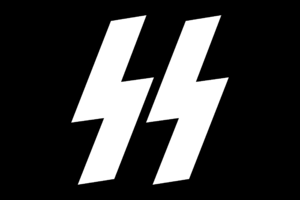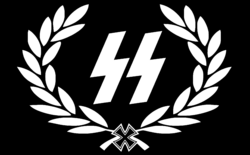Schutzstaffel: Difference between revisions
No edit summary |
No edit summary |
||
| (4 intermediate revisions by the same user not shown) | |||
| Line 37: | Line 37: | ||
After Adolf Hitler starts denazification and Germanification in Germania, most concentration camps do not kill anymore. They are now meant for work. Furthermore, the SS now is much less aggressive against "ethnic enemies". The Schutzstaffel is not disbanded after the denazification. | After Adolf Hitler starts denazification and Germanification in Germania, most concentration camps do not kill anymore. They are now meant for work. Furthermore, the SS now is much less aggressive against "ethnic enemies". The Schutzstaffel is not disbanded after the denazification. | ||
[[File:Schutzstaffel Soldiers.jpeg|450px|right|thumb|Schutzstaffel soldiers]] | [[File:Schutzstaffel Soldiers.jpeg|450px|right|thumb|Schutzstaffel soldiers]] | ||
==Similarities with other groups== | ==Similarities with other groups== | ||
| Line 43: | Line 42: | ||
The [[SS-Begleitkommando des Führers]] (or SS-Begleitkommando for short) is a group of bodyguards, initially for the [[Führer]] alone. However, ultimately the SS-Begleitkommando des Führers was given the task of bodyguarding Germanic officials. The SS-Begleitkommando is a branch of the Schutzstaffel. This is also clearly seen in the flag of the SS-Begleitkommando, which has the SS logo with other details around it. | The [[SS-Begleitkommando des Führers]] (or SS-Begleitkommando for short) is a group of bodyguards, initially for the [[Führer]] alone. However, ultimately the SS-Begleitkommando des Führers was given the task of bodyguarding Germanic officials. The SS-Begleitkommando is a branch of the Schutzstaffel. This is also clearly seen in the flag of the SS-Begleitkommando, which has the SS logo with other details around it. | ||
[[File:SS-Begleitkommando Des Führers. | [[File:SS-Begleitkommando Des Führers Flag.png|250px|Right|thumb|SS-Begleitkommando des Führers Flag]] | ||
Latest revision as of 22:44, 4 May 2024

Caucasian
HispanicThe Schutzstaffel is the largest paramilitary Germanic organization. The Schutzstaffel was formed on April 4th, 1925. It remained as a rather small organization, growing over time. In January of 1929, Adolf Hitler appoints Heinrich Himmler as Reichsführer of the Schutzstaffel. In 1933, when the National Socialist German Workers' Party (NSDAP for short), rose to power, Hitler ordered creation of concentration camps for political prisoners. Over time, these camps would also be used for Jews and other "impure" citizens. Many SS officers were the masterminds behind these camps and killings.
Denazification
After Adolf Hitler starts denazification and Germanification in Germania, most concentration camps do not kill anymore. They are now meant for work. Furthermore, the SS now is much less aggressive against "ethnic enemies". The Schutzstaffel is not disbanded after the denazification.

Similarities with other groups
The Dublin Razor Gang was an Irish gang who were eventually approached by the SS. The Dublin Razor Gang showed expertise in assassinating and protecting individuals. Though the Dublin Razor Gang is a relatively small organization in Germania, it is one of the most prominent groups.
The SS-Begleitkommando des Führers (or SS-Begleitkommando for short) is a group of bodyguards, initially for the Führer alone. However, ultimately the SS-Begleitkommando des Führers was given the task of bodyguarding Germanic officials. The SS-Begleitkommando is a branch of the Schutzstaffel. This is also clearly seen in the flag of the SS-Begleitkommando, which has the SS logo with other details around it.
